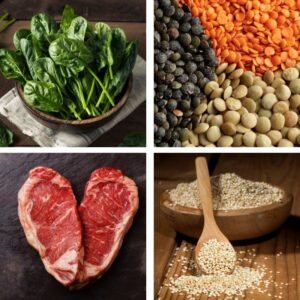Iron deficiency is a common nutritional issue affecting millions of people worldwide, with women being particularly vulnerable. We’ll explore why women are at higher risk, the symptoms to watch out for, and effective strategies to manage and prevent this condition.
Why Are Women More at Risk?
Menstrual Cycle
One of the primary reasons women are more susceptible to iron deficiency is menstruation. Each month, women lose blood during their period, which also means they lose iron. For women with heavy menstrual bleeding (menorrhagia), this loss can be even more significant.
Pregnancy
During pregnancy, the body’s demand for iron increases substantially. This is due to the need to support the growing fetus and the increase in blood volume. If a woman is already deficient in iron before pregnancy, this can exacerbate the problem.
Dietary Factors
Women, particularly those who follow vegetarian or vegan diets, may not get enough iron from their food. Iron is found in two forms: heme (from animal sources) and non-heme (from plant sources). Heme iron is more readily absorbed by the body. Therefore, women who do not consume meat or seafood need to be particularly mindful of their iron intake.
Recognizing the Symptoms
Iron deficiency can present with a range of symptoms, many of which can impact daily life. Key symptoms include:
 Fatigue: A common and often debilitating symptom, fatigue occurs because iron is crucial for producing hemoglobin, which helps carry oxygen throughout the body.
Fatigue: A common and often debilitating symptom, fatigue occurs because iron is crucial for producing hemoglobin, which helps carry oxygen throughout the body.
Paleness: A noticeable paleness in the skin and mucous membranes can be a sign of low iron levels.
Shortness of Breath: As iron levels drop, the body has less capacity to transport oxygen, leading to feelings of breathlessness.
Cold Hands and Feet: Poor oxygen delivery can cause extremities to feel cold.
Hair Loss: Iron deficiency can lead to brittle hair and increased hair loss.
Restless Legs Syndrome: Some women with iron deficiency experience an uncomfortable sensation in their legs, often accompanied by an uncontrollable urge to move them.
How to Address Iron Deficiency
Dietary Changes
 Incorporate iron-rich foods into your diet. For those who eat animal products, red meat, poultry, and fish are excellent sources of heme iron. For vegetarians, focus on non-heme iron sources like lentils, beans, tofu, and fortified cereals. Pairing these foods with vitamin C-rich foods (like oranges or bell peppers) can enhance iron absorption.
Incorporate iron-rich foods into your diet. For those who eat animal products, red meat, poultry, and fish are excellent sources of heme iron. For vegetarians, focus on non-heme iron sources like lentils, beans, tofu, and fortified cereals. Pairing these foods with vitamin C-rich foods (like oranges or bell peppers) can enhance iron absorption.
Supplements
Iron supplements are commonly used to treat iron deficiency. However, they should be taken under medical supervision, as excessive iron can lead to health issues. Your doctor will recommend the appropriate dosage and type of iron supplement based on your individual needs.
Regular Check-ups
If you have symptoms of iron deficiency or are at risk due to menstruation or pregnancy, talk to us!!
Managing Menstrual Bleeding
For women with heavy menstrual bleeding, managing this condition with medical assistance can help reduce iron loss.
Moving Forward
Iron deficiency in women is a manageable condition, but it requires awareness and proactive steps to be properly addressed. By understanding the risk factors, recognizing the symptoms, and taking appropriate measures, women can effectively manage their iron levels and maintain overall health.
Discover more about this topic at the CDC website.
Learn how PPMA can help you achieve your best health. PPMA can help you with personalized healthcare services tailored to your needs.
